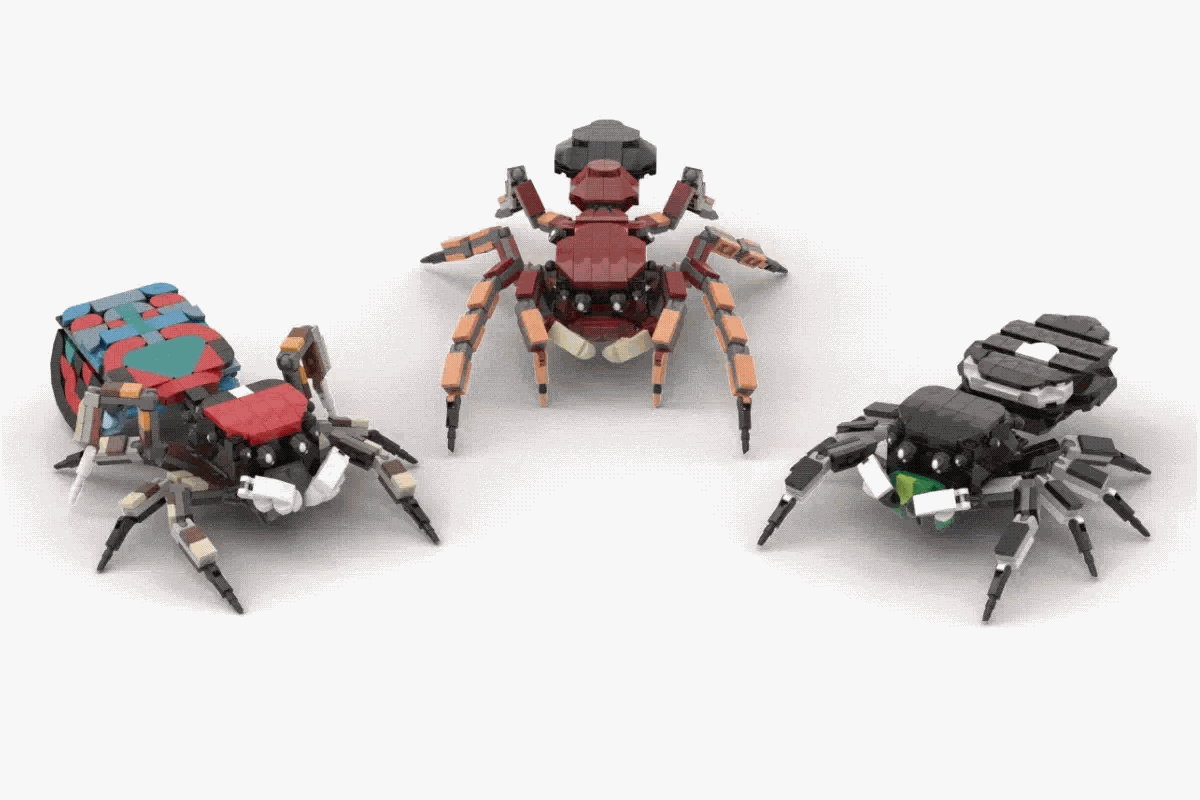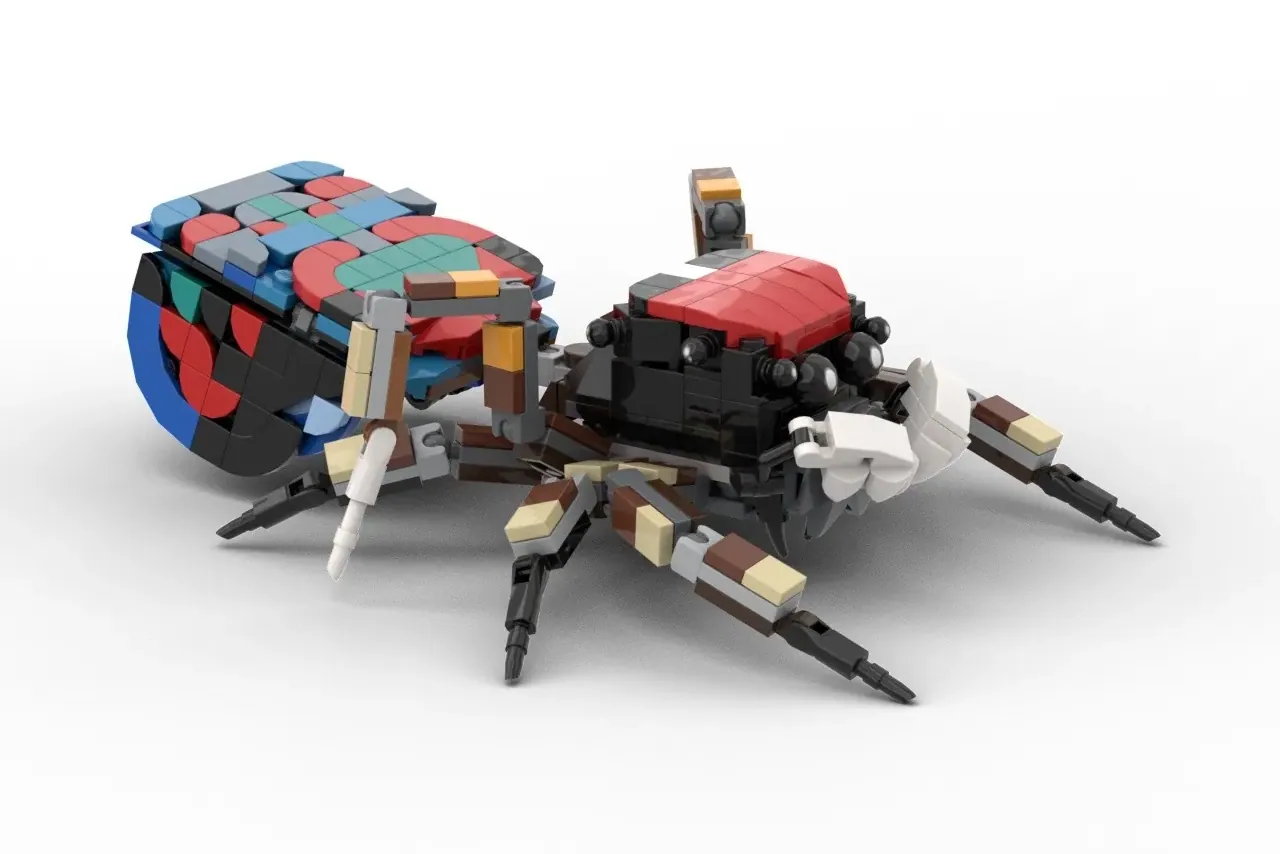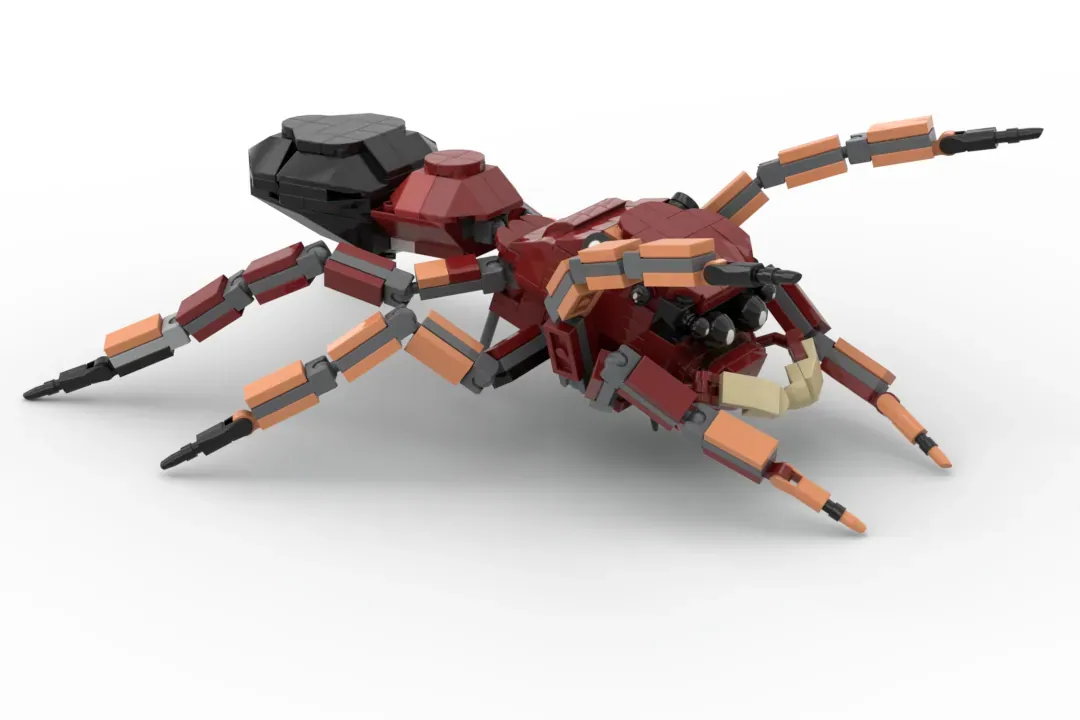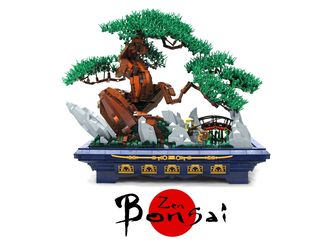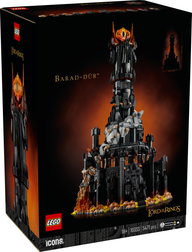跳蛛
Jumping Spiders
作者:spiderdude / 发布于:2023-05-02
大家好,
请小心观察到的蜘蛛,不要在不了解当地蜘蛛种类的情况下随意触碰它们。大多数蜘蛛都是无害的。这个项目的目的是帮助大家了解这些有趣又迷人的生物,让大家明白蜘蛛并没有想象中那么可怕——我们可以将恐惧转化为好奇。
什么是跳蛛(Jumping Spider)?
跳蛛是蜘蛛中最可爱的种类之一,属于跳蛛科(Salticidae)。这是目前已知种类最多、最多样化的蜘蛛家族,占所有已描述蜘蛛种类的约13%,共有6500多个物种。
它们遍布全球,生活在各种环境中。跳蛛是白天活动的猎手,不织网也不躲在洞穴里捕食,而是依靠敏锐的视力捕捉猎物,并用丝线作为跳跃时的安全绳索。它们能跳跃自身长度3到30倍的距离!
跳蛛体色丰富、形态多样,体型从3毫米到2.5厘米不等。它们性格好奇,喜欢探索环境,虽然有些种类比较害羞,但对人类完全无害。
跳蛛的眼睛结构:
跳蛛有八只眼睛,每一对都有特定的功能。最前面的两对大眼睛(前中眼)用于精准地锁定猎物,部分跳蛛甚至可以感知完整的色彩光谱,拥有节肢动物中最清晰的视觉之一。
它们的主眼像望远镜一样工作,通过眼球内部瞳孔的前后移动来判断距离。其余六只眼睛虽不能提供彩色视觉,但能为它们提供360度的全景视野。
乐高模型展示:
本项目共制作了三款不同种类的跳蛛模型,以展现跳蛛世界的多样性:
1. 蓝孔雀跳蛛(Maratus caeruleus)
- 分布范围:澳大利亚西部的孤立岛屿
- 体长:雄性5毫米,雌性未知
- 特点:
- 属于“孔雀跳蛛属”,是蜘蛛界的明星。
- 雄性具有鲜艳的腹部图案,并通过独特的舞蹈吸引雌性。
- 舞蹈动作复杂,包括抬起腿和展开彩腹。
- 雌性颜色较单调,体型略大。
- 自2011年起,许多新种被陆续发现,其中一些由科学家和公众共同完成。
选择理由:因其头部红色区域和腹部独特图案适合用乐高还原。
2. 未定种蚂蚁拟态跳蛛(Peckhamia .sp)
- 分布范围:北美
- 体长:约3–4毫米
- 特点:
- 属于蚂蚁拟态跳蛛,模仿蚂蚁的外形和行为。
- 利用第二对前足模拟蚂蚁触角。
- 某些种类还会释放化学物质伪装成蚂蚁,避免被捕食者攻击。
- 是一种生存策略,帮助其躲避天敌。
选择理由:因其红色特征明显且具有有趣的拟态行为。
3. 勇敢跳蛛(Phidippus audax)
- 分布范围:北美、加拿大南部、墨西哥北部及夏威夷
- 体长:雄性1.2厘米,雌性1.4–1.5厘米
- 特点:
- 雄性使用闪亮的蓝绿色螯肢进行求偶表演。
- 年轻个体腹部有橙色斑点,成熟后变为白色。
- 头部上方有类似“眉毛”的毛发。
选择理由:这是北美地区最常见的跳蛛之一,具有代表性。
结语:
我一直对蜘蛛、昆虫和爬行动物充满兴趣,喜欢拍摄、绘画并记录身边的生物多样性。每天花30分钟观察花园,你总能发现新奇的事物,甚至可能是科学界尚未发现的新物种。
目前,只有大约三分之一到五分之一的蜘蛛种类被正式命名,而昆虫更是只发现了不到10%。我们对地球生物多样性的探索才刚刚开始。
你可以通过以下方式了解更多本地蜘蛛信息:
- 使用蜘蛛识别手册
- 查阅博物馆网站上的在线资源
- 实地参观博物馆观察标本
此外,还有一些飞蛾、苍蝇和蜡蝉会模仿跳蛛的眼睛图案,这种现象称为“部分拟态”,例如:
- Ceratitis millicentae(蝇类)
- Nymphicula blandialis(蛾类)
- Brenthia .sp(蜡蝉)
感谢阅读!希望你喜欢这个项目,请分享给家人和朋友吧。
模型尺寸与零件数量:
Caerulean-blue Peacock Spider (Maratus Caeruleus)
模型大小:
凸点:18 x 19 x 14
厘米:14.4 x 15.2 x 11.2
英寸:5.66 x 5.98 x 4.40
零件数:407件
Peckhamia .sp
模型大小:
凸点:23 x 21 x 7
厘米:18.4 x 16.8 x 5.6
英寸:7.24 x 6.61 x 2.20
零件数:334件
Bold Jumping Spider (Phidippus Audax)
模型大小:
凸点:19 x 23 x 7
厘米:15.2 x 18.4 x 5.6
英寸:5.98 x 5.79 x 2.20
零件数:308件
总零件数:1049件
请小心观察到的蜘蛛,不要在不了解当地蜘蛛种类的情况下随意触碰它们。大多数蜘蛛都是无害的。这个项目的目的是帮助大家了解这些有趣又迷人的生物,让大家明白蜘蛛并没有想象中那么可怕——我们可以将恐惧转化为好奇。
什么是跳蛛(Jumping Spider)?
跳蛛是蜘蛛中最可爱的种类之一,属于跳蛛科(Salticidae)。这是目前已知种类最多、最多样化的蜘蛛家族,占所有已描述蜘蛛种类的约13%,共有6500多个物种。
它们遍布全球,生活在各种环境中。跳蛛是白天活动的猎手,不织网也不躲在洞穴里捕食,而是依靠敏锐的视力捕捉猎物,并用丝线作为跳跃时的安全绳索。它们能跳跃自身长度3到30倍的距离!
跳蛛体色丰富、形态多样,体型从3毫米到2.5厘米不等。它们性格好奇,喜欢探索环境,虽然有些种类比较害羞,但对人类完全无害。
跳蛛的眼睛结构:
跳蛛有八只眼睛,每一对都有特定的功能。最前面的两对大眼睛(前中眼)用于精准地锁定猎物,部分跳蛛甚至可以感知完整的色彩光谱,拥有节肢动物中最清晰的视觉之一。
它们的主眼像望远镜一样工作,通过眼球内部瞳孔的前后移动来判断距离。其余六只眼睛虽不能提供彩色视觉,但能为它们提供360度的全景视野。
乐高模型展示:
本项目共制作了三款不同种类的跳蛛模型,以展现跳蛛世界的多样性:
1. 蓝孔雀跳蛛(Maratus caeruleus)
- 分布范围:澳大利亚西部的孤立岛屿
- 体长:雄性5毫米,雌性未知
- 特点:
- 属于“孔雀跳蛛属”,是蜘蛛界的明星。
- 雄性具有鲜艳的腹部图案,并通过独特的舞蹈吸引雌性。
- 舞蹈动作复杂,包括抬起腿和展开彩腹。
- 雌性颜色较单调,体型略大。
- 自2011年起,许多新种被陆续发现,其中一些由科学家和公众共同完成。
选择理由:因其头部红色区域和腹部独特图案适合用乐高还原。
2. 未定种蚂蚁拟态跳蛛(Peckhamia .sp)
- 分布范围:北美
- 体长:约3–4毫米
- 特点:
- 属于蚂蚁拟态跳蛛,模仿蚂蚁的外形和行为。
- 利用第二对前足模拟蚂蚁触角。
- 某些种类还会释放化学物质伪装成蚂蚁,避免被捕食者攻击。
- 是一种生存策略,帮助其躲避天敌。
选择理由:因其红色特征明显且具有有趣的拟态行为。
3. 勇敢跳蛛(Phidippus audax)
- 分布范围:北美、加拿大南部、墨西哥北部及夏威夷
- 体长:雄性1.2厘米,雌性1.4–1.5厘米
- 特点:
- 雄性使用闪亮的蓝绿色螯肢进行求偶表演。
- 年轻个体腹部有橙色斑点,成熟后变为白色。
- 头部上方有类似“眉毛”的毛发。
选择理由:这是北美地区最常见的跳蛛之一,具有代表性。
结语:
我一直对蜘蛛、昆虫和爬行动物充满兴趣,喜欢拍摄、绘画并记录身边的生物多样性。每天花30分钟观察花园,你总能发现新奇的事物,甚至可能是科学界尚未发现的新物种。
目前,只有大约三分之一到五分之一的蜘蛛种类被正式命名,而昆虫更是只发现了不到10%。我们对地球生物多样性的探索才刚刚开始。
你可以通过以下方式了解更多本地蜘蛛信息:
- 使用蜘蛛识别手册
- 查阅博物馆网站上的在线资源
- 实地参观博物馆观察标本
此外,还有一些飞蛾、苍蝇和蜡蝉会模仿跳蛛的眼睛图案,这种现象称为“部分拟态”,例如:
- Ceratitis millicentae(蝇类)
- Nymphicula blandialis(蛾类)
- Brenthia .sp(蜡蝉)
感谢阅读!希望你喜欢这个项目,请分享给家人和朋友吧。
模型尺寸与零件数量:
Caerulean-blue Peacock Spider (Maratus Caeruleus)
模型大小:
凸点:18 x 19 x 14
厘米:14.4 x 15.2 x 11.2
英寸:5.66 x 5.98 x 4.40
零件数:407件
Peckhamia .sp
模型大小:
凸点:23 x 21 x 7
厘米:18.4 x 16.8 x 5.6
英寸:7.24 x 6.61 x 2.20
零件数:334件
Bold Jumping Spider (Phidippus Audax)
模型大小:
凸点:19 x 23 x 7
厘米:15.2 x 18.4 x 5.6
英寸:5.98 x 5.79 x 2.20
零件数:308件
总零件数:1049件
🤖 以上为AI翻译概括,供参考。
Be cautious of the spiders you observe, do not handle spiders without the complete knowledge of spiders that are local to your region
. The majority of spiders are considered harmless. The aim of this project is to help encourage people to learn more about these cool and fascinating creatures. Spiders aren’t as scary as you may think. we can turn fear into fascination.
What is it?
Jumping Spiders are one of the cutest arachnids in the spider world. They are members of the family Salticidae, and are the most diverse and largest family group of spiders making up to be around 13% of all described spiders (6,500+ species). They are commonly found all over the world in a variety of habitats.
Jumping Spiders are daylight hunters as they don't build webs or shelter in burrows to catch prey, they rely on their vision to hunt prey and use their silk as a safety net to jump from one point to another. They can jump at incredible distances from 3 to 30 times their own body length.
They come in a variety of different colours and patterns and interesting body shapes. They come in many different body sizes as adults, from 3mm to 2.5cm in length (0.118in to 0.9in).
They are very curious creatures and love to explore, while some species can be quite shy, Jumping spiders are harmless to humans.
They have eight set of eyes used for specific functions, they rely on their two set of large front-facing primary eyes (anterior median eyes) to hunt for prey and some jumping spiders but not all can see in the full colour spectrum, they have one of the sharpest vision of all arthropods.
Their front facing eyes function as a telescopic lens where the pupils move back and forward within the eyes to see prey and calculate the distance to capture their prey. The other 6 eyes don’t have the best vision of the primary eyes and can only view the world in black and white but it gives them a 360 degree view of their surroundings.
Lego Model:
I've built 3 models for this project, I wanted to show different varieties of Jumping spiders that you may come across. While there are over 6,500 species described worldwide, I decided to build 1 Australian species and 2 American species. The 3 models are slightly different in shape but are not actual size comparison between each model. From left to right.
Caerulean-blue Peacock Spider (Maratus Caeruleus)
Species Range: Isolated Island in Western Australia
Size (Body length): Male: 5mm (0.19in) (Largest of all Maratus) and Female: unknown.
Facts:
- Peacock Spiders are the superstars of the spider world, they belong to the genus Maratus. There are over 110 species discovered in Australia while a few are yet to be discovered and all but one are endemic to Australia. The size of a adult male Peacock spider are incredibly tiny ranging from 2 to 5 millimetres (0.079 to 0.197in), the size of a grain of rice.
- The male are known as Peacock-like by the way they dance with their colourful abdomen to attract a female. All Male Peacock spiders have a unique and complex courtship dance that will attract the attention of female spiders by slowly raising their third pair of legs by waving them in a unique way and unfolding their uniquely shaped abdomen of brightly colourful patterns and then they dance, dance for their lives!
- The females mainly brown in colour and aren’t colourful as the males but are slightly larger which is common in many other spider families, females size are around 1 to 2 millimetres larger than the males (0.039 to 0.079 inches).
- Since 2011, Peacock Spiders have been discovered throughout Australia and a number of new discoveries have grown rapidly in the last 10 years by a number of biologists and citizen scientists. Jürgen Otto aka peacockspiderman, a arachnologist from Sydney, NSW who stumbled upon a species of Peacock spider, Maratus Volans in 2005. While the courtship dance wasn't known to science until 2008 when Jürgen and David Hill (arachnologist from the US) have started to observe, document and film the courtship behaviour of this species which has became a worldwide phenomenal.
I’ve chosen to build this Peacock spider because of his red colours on the cephalothorax and the interesting shapes of patterns on the abdomen to recreate them in Lego form.
Undescribed (Peckhamia .sp)
Species Range: North America
Size (Body length): Approx 3 to 4mm (0.118 to 0.157in)
Facts:
- The genus Peckhamia are Jumping spiders which are one of the few spiders that mimic Ants, they belong to the subtribe Synagelina. They are only found in North America while other species that mimic Ants belong to the tribe Myrmarachnini which can be found all over the world.
- Ant-mimicking jumping spiders can have a identical body shape and a similar colour pattern to those of ants in their specific regions.
- This species use their second set of front legs to simulate the antennas of ants, while other species can emit a chemical mimicry that makes it harder for aggressive ant colonies to detect intruders and it is one of the reasons many predators steer clear of preying on ants due to the unpleasant taste and their aggression, although some spiders do prey on ants.
I’ve chosen to build this Ant-mimic Jumping spider due to the red colour that stands out and being one of the main species featured online for their mimicry behaviour around ants.
Bold Jumping Spider (Phidippus Audax)
Species Range: North America, Southern Canada, Northern Mexico and Hawaii
Size (Body length): Male are 1.2 cm (0.47 in), Female 1.4 to 1.5 cm (0.55 to 0.59 in)
Facts
- Male Bold Jumping spiders use their colourful chelicerae (fangs) of iridescent blue and green as apart of the courtship dance by waving their forelegs and creating a rhythmic pattern by drumming the ground to attract a female.
- They can be seen with different colours due to their age, orange spots on the abdomen are seen in the younger spiders and the colours change to white as they mature.
- Bold Jumping spiders features small eyebrow hairs above the eyes.
I’ve chosen to build this Jumping spider because it is most commonly observed species in parts of North America, Southern Canada, Northern Mexico.
Conclusion
:
I have been fascinated of spiders, insects, reptiles and love to photograph, draw and document the biodiversity of spiders and insects that live around me in the garden, by spending 30mins a day in the garden, you will always find something new and possibly new to science.
It’s estimated that only one third to one fifth of existing species of spiders have only been described, it tells you how much species are out there that are not yet known to science, and for insects.. we only just discovered 10% of the world’s insects. we’ve only begun to scratch the surface of Earth’s biodiversity.
You can learn more about the spiders that are local to your region by getting your hands on a spider field guide book, online resources on spider identification from your local museum website and visiting your local museum to see the specimens in person.
There are a few species of moths, flies (yes, flies are fascinating too) and planthoppers that try to resemble the eye pattern of jumping spiders, also known as Partial mimicry.
species include
- Ceratitis millicentae (fly)
- Nymphicula blandialis (moth)
- Brenthia .sp (planthopper)
Thanks for reading and I hope your found this information fascinating and share this project with your friends and families :)
Model Size and Number of Parts:
Caerulean-blue Peacock Spider (Maratus Caeruleus)
Model size:
- Studs: 18 x 19 x 14
- Centimetres: 14.4 x 15.2 x 11.2
- Inches: 5.66 x 5.98 x 4.40
Pieces: 407 pecies
Peckhamia .sp
Model size:
- Studs: 23 x 21 x 7
- Centimetres: 18.4 x 16.8 x 5.6
- Inches: 7.24 x 6.61 x 2.20
Pieces: 334 pieces
Bold Jumping Spider (Phidippus Addax)
Model size:
- Studs: 19 x 23 x 7
- Centimetres: 15.2 x 18.4 x 5.6
- Inches: 5.98 x 5.79 x 2.20
Pieces: 308 pieces
Total Number of pieces: 1049 pieces
投稿状态
10000
票支持
待评审
状态
获得10000票支持 2025-05-09
获得5000票支持 2024-09-25
获得1000票支持 2024-03-14
获得100票支持 2023-05-08
作者投稿 2023-05-02
